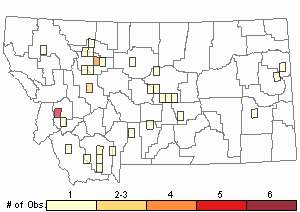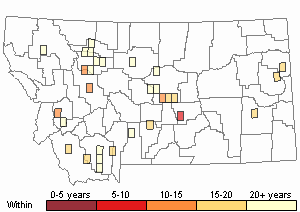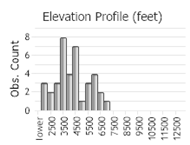View in other NatureServe Network Field Guides
NatureServe
Montana
Utah
Wyoming
Idaho
Wisconsin
British Columbia
South Carolina
Yukon
California
New York
A Diatom - Cymbopleura amphicephala
General Description
Morphological Category - Asymmetric biraphid.
Valves elliptic and slightly dorsiventral with a bit more curvature on the dorsal side.
Apices capitate to subcapitate, bent slightly towards the ventral margin.
Axial area narrow, located near valve midline.
Central area very small and asymmetric, formed by 1–3 short striae on one or both sides.
Raphe weakly lateral; proximal ends not expanded, deflected slightly towards ventral margin; distal fissures deflected dorsally.
Striae slightly radiate throughout, more closely spaced towards apices.
Size RangeLength 20–32 µm.
Width 6.4–8.7 µm.
Striae in 10 µm 12–16 center, up to 18 apices.
Areolae in 10 µm 32–35.
Useful Link:
Diatom Glossary [Diatoms of North America website]
Diagnostic Characteristics
Cymbopleura naviculiformis has somewhat larger and more dorsiventral valves, with a large rounded central area and a lateral raphe.
Cymbopleura anglica has larger valves, a lateral raphe, and a larger central area.
Cymbopleura frequens has linear-lanceolate valves, rostrate to apiculate apices and a larger length-to-width ratio. The apices of
Cymblopleura frequens are not bent to the ventral side, or are bent only slightly.
Cymbopleura similiformis has more linear and more bilaterally symmetric valves and apices that are straight, not bent towards the ventral margin.
Range Comments
Cymbopleura amphicephala is widely distributed throughout the northwestern United States. It primarily occurs in the mountainous regions but it can be found in streams on the plains. This diatom is rarely found in abundance.
Observations in Montana Natural Heritage Program Database
Number of Observations: 39
(Click on the following maps and charts to see full sized version)
Map Help and Descriptions
Relative Density

Recency



 (Observations spanning multiple months or years are excluded from time charts)
(Observations spanning multiple months or years are excluded from time charts)
Habitat
Small headwater lakes and streams.
Ecology
Cool, well-oxygenated, alkaline (calcium-bicarbonate) waters with moderate conductance.
WATER CHEMISTRY
Abundance-weighted means: pH = 8.4; conductivity = 334 µS/cm; temperature = 19.2 degrees Celsius.
Reproductive Characteristics
Diatoms typically reproduce by cell division (mitosis) and occasionally by meiosis—sexual reproduction in which female and male gametes combine to form a specialized zygote called an auxospore. Repeated divisions result in cells of a population becoming progressively smaller and smaller. When cells reach a critically small size, sexual reproduction is initiated, resulting in an auxospore and initial cells that are the largest attainable for the species, after which cell division and size reduction resume (Amato 2010).
Management
Generally considered to be an indicator of good water quality.
Stewardship Responsibility
References
- Literature Cited AboveLegend:
 View Online Publication
View Online Publication Amato, A. 2010. Diatom reproductive biology: living in a crystal cage. The International Journal of Plant Reproductive Biology 2(1): 1-10.
Amato, A. 2010. Diatom reproductive biology: living in a crystal cage. The International Journal of Plant Reproductive Biology 2(1): 1-10. Bahls, L. 2012. Cymbopleura amphicephala In: Diatoms of North America. Accessed 08 October 2019. https://diatoms.org/species/cymbopleura_amphicephala
Bahls, L. 2012. Cymbopleura amphicephala In: Diatoms of North America. Accessed 08 October 2019. https://diatoms.org/species/cymbopleura_amphicephala Bahls, L. 2019. Cymbellafalsa, Cymbopleura and Delicatophycus (Bacillariophyta) —Taxonomy, Ecology, Biogeography In: Diatoms from Western North America. The Montana Diatom Collection. Helena, MT. 114 p.
Bahls, L. 2019. Cymbellafalsa, Cymbopleura and Delicatophycus (Bacillariophyta) —Taxonomy, Ecology, Biogeography In: Diatoms from Western North America. The Montana Diatom Collection. Helena, MT. 114 p.
- Web Search Engines for Articles on "A Diatom"





